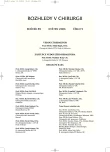Laparoscopic Rectopexis
Authors:
R. Gürlich 1,3; B. Sixta 1; P. Drastich 2; M. Beneš 2; J. Čermák 3; M. Oliverius 1; J. Šváb 3
Authors‘ workplace:
Klinika transplantační chirurgie IKEM, přednosta doc. MUDr. M. Adamec, CSc.
1; Klinika hepatogastroenterologie IKEM, přednosta doc. MUDr. J. Špičák, CSc.
2; I. chirurgická klinika 1. LF UK Praha, přednosta doc. MUDr. J. Šváb, CSc.
3
Published in:
Rozhl. Chir., 2006, roč. 85, č. 5, s. 233-235.
Category:
Monothematic special - Original
Overview
Introduction:
Rektopexis is an effective treatment method of rectal prolapses. Our retrospective study assessed the laparoscopic rectopexis results.
Methodology:
From 01-01-2003 to 31-11-2005, 10 patients were indicated for the procedure of laparoscopic retropexis. A “Vypro“ mesh (Johnson&Johnson) was used to suspend the rectum. We fix it to the sacrum and to the rectum with an anchor (Eanchr, Johnson&Johnson). The follow-up examinations were conducted 2-30 months after the procedure. We assessed mortality rates, morbidity rates, the prolaps relapses incidence rates, obstipation incidence rates.
Results:
The laparoscopic procedure was completed in 9 patients. In one case, we converted. The mortality and serious postoperative morbidity rate was 0%. The mean duration of hospitalization was 7 days. During the follow-up, no patient relapsed. One female patient complained of mild postoperative obstipation, which, however, did not require surgical revision.
Conclusion:
Laparoscopic rectopexis is a modern, safe and effective method of the prolaps of the rectum treatment.
Key words:
laparoscopy – rectopexis – prolaps of the rectum
Labels
Surgery Orthopaedics Trauma surgeryArticle was published in
Perspectives in Surgery

2006 Issue 5
Most read in this issue
- Laparoscopic Rectopexis
- Tracheal Tumor – A Case Review
- Percutaneous Cholecystostomy in Acute Cholecystitis – A Solution for Risk Patient Groups?
- Pancreatectoduodenectomy for Multiple Duodenal Diverticula. Case Report
